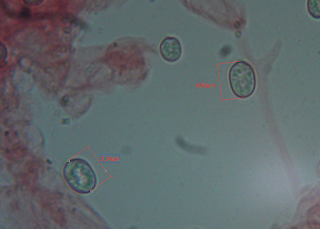Sussex Fungus Group was back in action yesterday for the first foray of the season, in an area of mixed woodland near Northchapel, West Sussex.
The fungus we found fruiting in most profusion has to be this white ascomycete growing on fallen Ash petioles, assumed to be Hymenoscyphus fraxineus, aka Ash Dieback. Nick Aplin has recorded H. fraxineus before on this site, so it is known to be present. But the record will still need to be confirmed by examination of its microscopic features.
I thought I'd have a go at determining this myself, using descriptions in Baral and Bemmann (2014). They explain that one of the key features of H. fraxineus which distinguishes it from other similar species is the presence of 'croziers' (hook-type things on the hyphae, similar to 'clamps'). But I've given up. Too difficult!
 |
| Some Hymenoscyphus bits. Asci n' stuff? |
I won't list everything we found, but there were some interesting things about which are worth a mention.
Nick Aplin identified this creeping white stuff as Polycephalomyces tomentosus, a tiny fungus which grows on slime moulds. You could mistake it for Ceratiomyxa fruticulosa from a distance, but this species is very distinctive up close. I found a fabulous macro photo of P. tomentosus here, by Johan Dierckx.
This mossy collar around the narrow trunk of a living Spindle Euonymus europaeus is in fact a ring of bracket fungus fruiting bodies.
The fruit bodies had cinnamon pores. I'm gonna take a wild guess at this being Phylloporia ribis, which Ryvarden & Melo (2017) describe as "often encircling the branch or stem on which it is growing", "usually easy to recognise by its small basidiocarps on thin branches or at the base of thin stems"... "Euonymus seems to be the most common host". Nick took a specimen so will look forward to hearing what he makes of it.
The Foetid Parachute Gymnopus foetidus (= Micromphale foetidum) had appeared on the same log pile where we found it previously, in 2016.
I volunteered to take a look at these green/turquoise elfcups Chlorociboria sp. to determine which of the two very-similar-looking species this is. I'll need to measure the spores so I'm hoping to get a spore print.
Nick also handed me some TINY yellow dots growing on wet, well-rotted wood. Here's a close-up under the stereomicroscope.
They sure don't look like much to the naked eye. But they've got these GIGANTIC conidia. I found a nice piece about this species in the North West Fungus Group newsletter, here (opens as pdf, see page 5), if you want to know more about this crazy little dude.
 |
| Mounted in water. 100x magnification. |
The find of the foray, for me, has to be Weeping Widow Lacrymaria lacrymabunda. It's a common and widespread species, but I'd never seen it before.
It gets its name from the watery droplets that appear on the cap rim and gill edges. The persistent rain provided ideal conditions to see this phenomenon!
The cap and veil are fibrous, giving the mushroom the appearance of being capped with felt.
And it's got these warty spores.
Oh and I'm also supposed to be having a go at confirming the identity of one of these grey Pluteus we found about the place. But I've been distracted by all that other funky stuff.
Have had a quick look but got in a muddle going through the keys. Images are at 400x magnification, stained with Congo Red and mounted in water.
 |
| Pileipellis: image is of a thin slice from the top of the cap. Is this a cutis? I don't know. |
 | |
| Horned cystidia.This should narrow things down... |
 |
| I'm confused about what the 'clavate' balloon things are. |
 |
| Broadly ellipsoid spores. |
 |
| I make the spores about 8 - 9 microns in length. |
References
Baral, Hans-Otto & Bemmann, Martin. (2014). Hymenoscyphus fraxineus vs. Hymenoscyphus albidus – A comparative light microscopic study on the causal agent of European ash dieback and related foliicolous, stroma-forming species. Mycology. 5. 228-290. https://doi.org/10.1080/21501203.2014.963720
For the record
Date: 26 August 2018
Location: Private site near Northchapel
All records to be submitted by Nick Aplin, Sussex Fungus Group













No comments:
Post a Comment